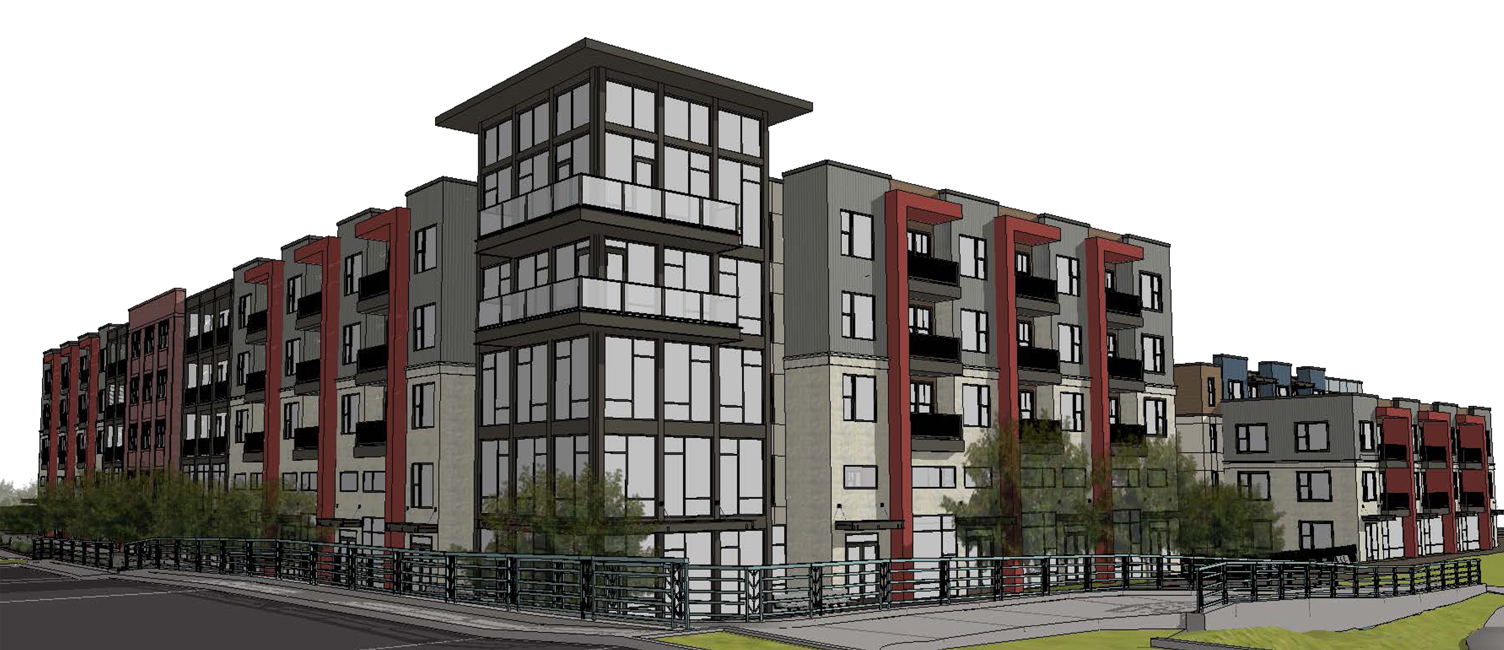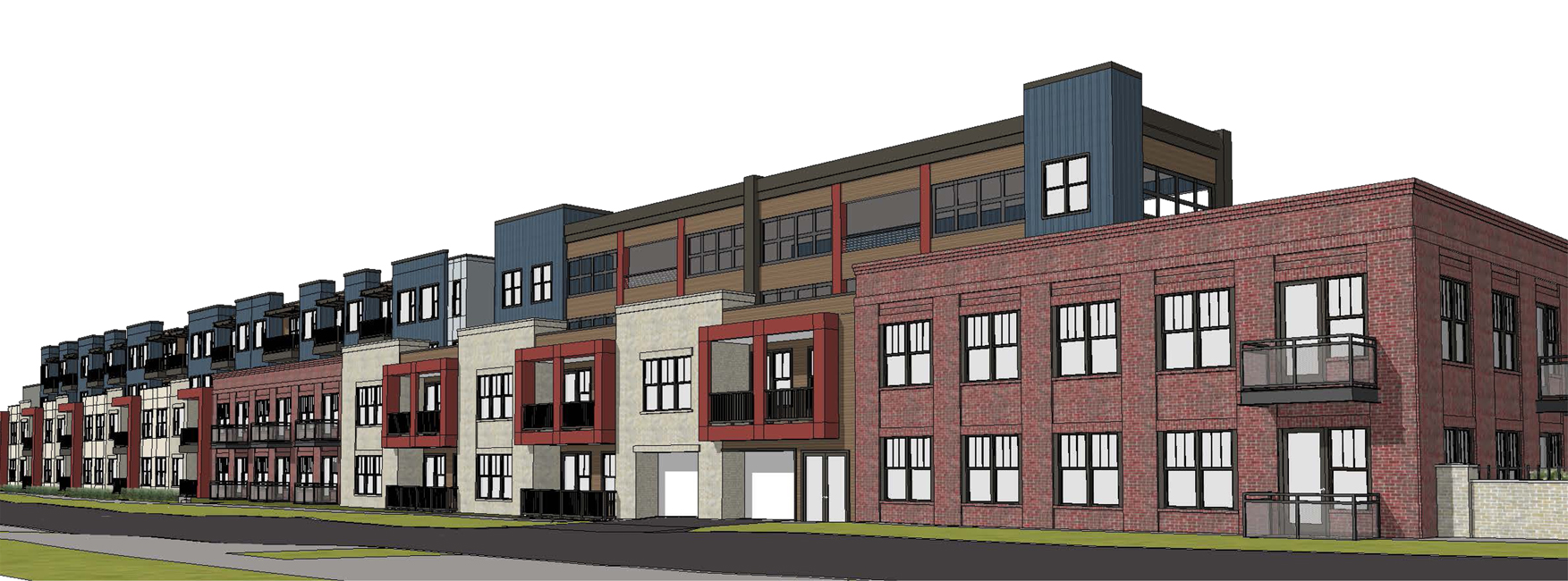MNA & SASYNA want a say as developer submits formal plans to City

A view of the mixed-used development proposed for the Marling site at 1801 E. Washington Avenue.
Talk of redeveloping the Marling Lumber site has existed for over a year, but has found new momentum after a public meeting in September where developers, Campbell Capital Group, LLC., presented their plan to redevelop the site featuring a largely residential mixed-use development.
Late last month Campbell Capital submitted their plan to the City of Madison to build a 230 unit apartment complex with 20,000 square feet of commercial space, mostly on East Washington Avenue. In a Letter of Intent to the City, CCG Founder Micheal J. Campbell proposed the two to four story interconnected buildings would blend in with the neighborhood by presenting welcoming features both along East Washington and the Yahara River.
“A public plaza along the Yahara River connects and integrates the Project and its residents with the surrounding neighborhood. This sense of community, and interaction at the street level, is further enhanced by the exterior entrances to some of the residential units along East Main Street,” Campbell wrote.
One hundred and fifty of the 230 units will be 1-bedroom, 78 are 2-bed, and three will be 3-bed with the average square footage of each unit adding up to 811 square feet. There will also be three courtyards, an outdoor pool, interior structured parking with 334 spaces and 265 spaces for bicycles.
The site, located at 1801 E. Washington Avenue, falls within the boundaries of the Marquette neighborhood but is adjacent to Schenk-Atwood and both communities have a rooting interest in seeing the basically moribund site rehabilitated. Both neighborhoods have seen an acceleration in both proposed and actual developments along it’s now iconic main thoroughfares and now they are joining forces to make sure it’s interests and tastes are represented in this current project.
In a letter to District 6 Alder Marsha Rummel, the Marquette Neighborhood and the Schenk Atwood Starkweather Yahara Neighborhood associations announced their planning and development units have formed a joint committee to advise the City and the Developers on neighborhood concerns regarding the project.
“Our goal in raising these concerns is not to stop the project, but to make it better,” wrote MNA’s Jesse Pycha-Holst and SASYNA’s Brad Hinkfuss.

The East Main side of the development appears especially devoid of personality.
The letter shows the committee has already taken considerable time to analyze the project offering eight preliminary concerns over the design, construction and marketing focus of the project. The committee felt the Yahara-side public spaces could be improved and units along East Main Street should all have entrances to continue the residential feel that the single family homes on the south side of the street give to the neighborhood.
The Committee also noted that building materials were too varied and could be simplified, a traffic study was needed and they expressed fears that affordable housing was in danger of becoming an afterthought.
Needs work
A first look at the public documents submitted by CCG underwhelms. We are off to a great start in redeveloping the Capital East Corridor, but we need exceptional designs and at the moment this one seems boring. It also seems insular and mildly unwelcoming in that all of it’s living and play space seems turned inward.
While the developer is trying to engage the Yahara river, the design needs more inspiration. However, the glass atrium-like concept at the corner of East Washington and the Yahara River is a good start.
Frankly the Lego block, Lincoln log look to the rhythm and voids of the buildings is the most ho-hum portion of the design and reminds me a little of the rambling apartment blocks of the suburban fringe. This type of design fits better their wide grassy vistas and retention ponds with mechanical fountains rather than the unique setting along the Yahara river.
Additionally, the committee was right to call attention to the lack of a sizable affordable housing contingent. The rental vacancy crisis is real in this city, especially in the isthmus. It is our job as neighbors to ensure that housing capacity created in our hoods is accessible to all income classes.
It is heartening to see that CCG is not asking for public financing, but that should not preclude our neighborhoods from driving changes to the plan that will more align the project with our development goals.
CCG is requesting rezoning of the area from Industrial Limited (IL) to Traditional Employment (TE) along with a conditional use permit which the joint neighborhood committee is against until there has been more time to provide community feedback. CCG has offered to meet with the neighborhoods later this month.
Read: Campbell Capital Group Letter of Intent
View: CCG Site Overview
Read: MNA-SAYNA Letter to Alder Marsha Rummel


Simplify the design and build it! I
If you want to know why the vast majority of infill apartments have that over-articulated facade with a downright shmorgasborg of building materials, look no further than the personal design preferences foisted onto developers via certain city staff and committee members who have dominated the development process for years on end. Developers know what they’ve wanted, and design with them in mind, even though I know they strongly desire better, different looking buildings! Looking at the city’s and neighborhood design standards, they specifically call for facade that look as stupid as this one. We reap what we sow, I guess.
As to the affordable housing, I think its important to have new construction affordable housing in the neighborhood, but at the end of the day if we allowed developers to add enough housing supply to meet demand, prices would naturally be more affordable in market rate housing. Of course, guys like Ray Peterson don’t help by keeping affordable housing too affordable, but luckily the city was able to go after him and force the liquidation of his substantial holdings in the neighborhood.
Seriously though, remember every time you delay a project, rental prices slowly creep up for the neighborhood. The only thing that keeping Willy from being totally redeveloped is the presence of many ma-and-pa landlords who haven’t figured out that the household income of their tenants is over $100k, and they can renovate and substantially up their cashflow while increasing the value of the underlying asset. Adding more new construction market rate units relieves pressure on the existing housing stock, and will create less of an incentive to retenant those wonderful Victorian three-flats.